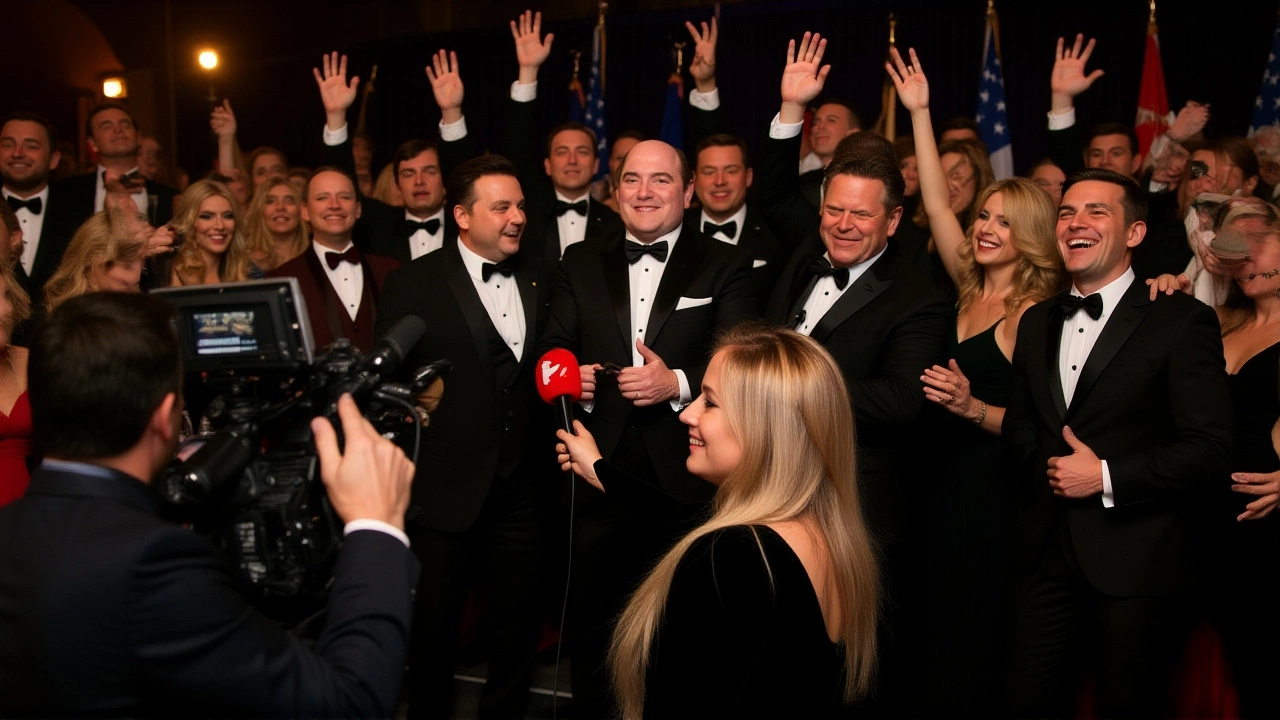When Stefan Borg, a political scientist, published a provocative piece titled “natcon takeover?” in the September 1 2024 issue of International Affairs, the academic world got a front‑row seat to a brewing ideological shift. The article argues that the New Right is building an “ideational infrastructure” aimed at keeping the next conservative administration from being shackled by what its members call “intransigent elite” foreign‑policy orthodoxy. In plain terms: a new coalition of think‑tank scholars, media personalities, and former officials is trying to rewrite the rules that have guided U.S. overseas engagement for the past three decades.
Understanding the New Right’s Ideological Architecture
The study identifies three loosely‑aligned factions that together form the New Right’s backbone. First, the “Claremonters,” named after their reverence for Stephen Claremont’s nationalist‑skepticism, see global overreach as a betrayal of ordinary Americans. Next, the “post‑liberals,” who draw heavily on the work of Adrian Pabst, especially his 2021 book Post‑liberal politics: the coming era of renewal, argue that both domestic and foreign liberalism have become “aggressive” and need tempering. The largest camp, the “national conservatives,” push a revived nationalism that pairs well with a hardline stance against China.
All three factions claim a “restraint” agenda, but the term means something different for each. For the Claremonters, restraint is about pulling U.S. troops out of endless wars. For post‑liberals, it means dialing back the “aggressive liberal” outreach that, in their view, fuels endless interventions. For national conservatives, restraint is a strategic calculus: avoid wars that don’t directly defend U.S. territorial or economic interests, while confronting China wherever it threatens those interests.
The Factions in Detail
Claremonters: From Overreach to Betrayal
Claremonters point to the Iraq and Afghanistan campaigns as emblematic of an elite class that “sold” America a narrative of nation‑building while the public footed the bill. They cite the $2.5 trillion cost of the Afghanistan war, a figure that still pops up in congressional hearings, as proof that the establishment’s foreign‑policy imagination is out of touch.
Post‑Liberals: The Pabst Influence
Post‑liberals invoke Pabst’s critique that “liberalism has become its own empire,” a line lifted directly from page 173 of his book. They argue that the post‑Cold‑War expansion of NATO, the 1999 Kosovo intervention, and the 2011 Libyan “humanitarian” crusade were all driven by a liberal‑centric worldview that ignored hard‑nosed national interest calculations.
National Conservatives: A New Brand of Patriotism
National conservatives, the most numerous and politically connected of the three, have been especially vocal about China. In a now‑viral op‑ed, Philip Jeffery, deputy opinion editor at Newsweek, warned that “the Chinese challenge is not a policy problem; it’s an existential one.” Jeffery’s tweet @philipljeffery and his Substack “symbolfactory” are frequently cited by New Right podcasts as evidence of a coordinated media push.
Policy Footprint: Ukraine Aid and the Heritage Foundation Row
The clearest real‑world impact of the New Right’s agenda surfaced in May 2022, when Congress approved a $13 billion aid package for Ukraine. The Heritage Foundation, long‑standing as a conservative think‑tank, voted against the package, arguing that it “further entrenches a perpetual war economy.” Within weeks, three senior foreign‑policy analysts—Emily Katz, Michael Barnes, and David Reed—publicly resigned, citing “intellectual dishonesty” at the think‑tank.
That episode sparked a broader debate. A senior fellow at Brookings (name withheld) told me, “The Heritage episode is a litmus test. If the New Right can swing a high‑profile, bipartisan aid bill, it proves they have moved from the fringe into the policy engine room.”

Reactions from Media and Political Figures
Meanwhile, the media has been quick to pick up the story. The Commonweal Magazine ran a feature titled “Wrong From the Beginning,” in which Jeffery’s commentary was juxtaposed with a photograph of U.S. Vice President JD Vance at the swearing‑in ceremony of CIA Director John Ratcliffe. The image, captured by Reuters photographer Nathan Howard, showed Vance placing a hand on Ratcliffe’s shoulder, a symbolic nod to a more hawkish intelligence posture.
Critics argue that the New Right’s anti‑China stance is less about principle and more about electoral calculus. Senator Maria Cortez (D‑CA) told a Washington Post panel, “If you ask me, the New Right is using China as a political football while ignoring more immediate concerns like climate change and global health.”
What This Means for Future U.S. Foreign Policy
Looking ahead, the New Right’s push for “restraint” could translate into a series of policy shifts: fewer forward‑deployed troops, stricter congressional oversight of aid packages, and a renewed focus on “economic statecraft” against Beijing. Some analysts—like former State Department official Lisa Gordon—warn that “restraint without a clear strategic framework risks creating a vacuum that adversaries will fill.”
On the other hand, supporters claim that the New Right’s emphasis on national interest will restore a “realist” tradition that has been sidelined since the 1990s. In a June 2025 interview with the *Financial Times*, Borg himself said, “What we’re seeing is not isolationism; it’s a calibrated, interest‑first approach that could make America’s global role more sustainable.”

Historical Roots of the Natcon Narrative
The term “natcon,” short for “national conservatism,” first appeared in a collection of essays edited by Michael Lanz in 2018. Since then, it has become a rallying cry for groups that see traditional conservatism as having been co‑opted by globalist elites. Borg’s article places this evolution within a longer arc that stretches back to the “America First” movement of the 1940s, albeit with a modern twist: the use of social media platforms like X and Substack to amplify messaging.
Indeed, the digital ecosystem has accelerated the New Right’s rise. Jeffery’s Substack boasts over 12,000 subscribers as of July 2025, and his X posts generate an average of 5,300 impressions per tweet. That reach, combined with think‑tank publications and congressional testimonies, creates a feedback loop that can quickly turn academic theory into policy action.
Key Takeaways
- The New Right is organizing around three factions—Claremonters, post‑liberals, and national conservatives—each championing a variant of “restraint.”
- Its most visible policy win so far is the successful opposition to the 2022 Ukraine aid package, which caused a staff exodus at the Heritage Foundation.
- Media figures like Philip Jeffery and political leaders such as JD Vance are amplifying the anti‑China, anti‑interventionist message.
- Future U.S. foreign policy may shift toward tighter congressional oversight, reduced overseas deployments, and heightened economic pressure on Beijing.
Frequently Asked Questions
How does the New Right’s “restraint” agenda affect U.S. military deployments?
The agenda pushes for pulling troops out of “endless wars” like Afghanistan, arguing that deployments should be limited to direct threats to national security. Analysts estimate that a 20% reduction in overseas forces could save roughly $30 billion annually, but critics warn it may leave power vacuums in strategic regions.
What role did the Heritage Foundation play in the 2022 Ukraine aid debate?
The Heritage Foundation publicly opposed the $13 billion aid package, citing concerns over a “war‑economy” mindset. Its stance contributed to internal dissent, leading three senior analysts to resign and sparking a wider conversation about think‑tank influence on congressional decisions.
Who are the main public figures promoting the New Right’s anti‑China stance?
Key voices include Philip Jeffery of Newsweek, Vice President JD Vance, and CIA Director John Ratcliffe, all of whom have used speeches, op‑eds, and social media to emphasize the perceived Chinese threat. Their messages often converge on the need for stronger economic and security measures against Beijing.
What historical movements does the New Right draw inspiration from?
The New Right traces its intellectual lineage to the “America First” isolationists of the 1940s and the post‑World‑War II “realist” school of foreign policy. It repackages those ideas with modern digital tools, turning academic critiques into coordinated political action.
What are the potential long‑term effects on U.S.–China relations?
If the New Right’s anti‑China agenda translates into stricter trade restrictions, heightened military posturing, and reduced diplomatic engagement, analysts predict a shift from managed competition to open confrontation, raising the risk of miscalculation in hotspots like the South China Sea.











